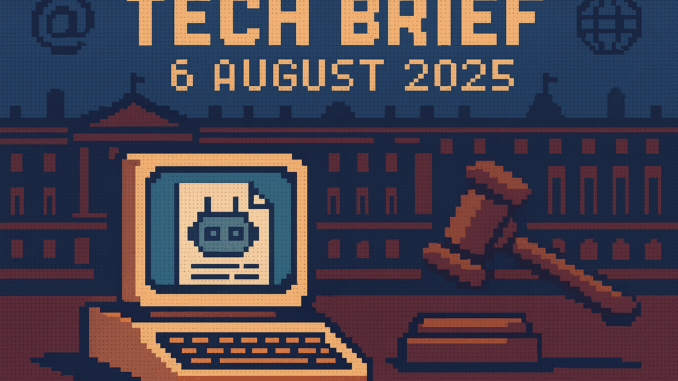
Tech Brief 6 August 2025 arrives as the UK’s digital landscape faces new scrutiny, AI models shift the power dynamic back to personal hardware, and the World Wide Web quietly celebrates a birthday that changed everything. Whether you’re here for the policy debates, hardware throwbacks, or just curious about what’s next, there’s something to dig into.
Missed yesterday’s Tech Brief? Catch up here before diving in.
UK Online Safety Act Ignites Old-School Free Speech Fears
“Is this just the new Digital Economy Act?” That’s the question echoing across discussion forums as the UK’s Online Safety Act becomes the focus of debates about government overreach and free speech. The law targets harmful content, including material related to self-harm and suicide, and has drawn criticism from both Nigel Farage and American commentators. Their main argument is that state-mandated moderation could stifle open discourse.
Unlike the days of Usenet or dial-up BBSes, moderation is now the responsibility of tech giants, under legal threat, rather than volunteer sysops. Defenders of the act cite the urgent need to protect children online, especially as digital platforms become more embedded in everyday life.
The tension between digital freedom and safety, once debated in the margins of fanzines, now sits centre stage in Parliament.
OpenAI’s Laptop-Ready Models Bring AI Back to the Desktop
A cold fact: OpenAI’s new open-weight reasoning models are optimised for laptops, not just cloud servers. That’s a genuine shift for anyone who remembers the thrill of running new software on a battered 486.
Instead of locking advanced artificial intelligence behind data centre walls, these models can be downloaded and run on consumer hardware. For anyone who cut their teeth on open-source projects or tinkered with early Linux, this feels like a return to the empowering spirit of the 90s. It’s not just about nostalgia, though. The models are designed for advanced reasoning tasks, so expect a new wave of DIY applications and homebrew experimentation.
This move is a pointed reminder: the pendulum of computing power swings back and forth, from mainframes to micros to clouds and now to your own machine.
McLaren Racing’s Digital Backbone: ITSM in the Fast Lane
How does a Formula One team keep pace in a world where milliseconds matter? And what does IT service management (ITSM) have to do with it?
Dan Keyworth, McLaren’s director of business technology, explains that today’s pit crew is as reliant on ITSM as they are on spanners. Modern F1 is a data-driven sport, with thousands of sensors feeding information to engineers in real time. McLaren’s digital infrastructure supports everything from logistics to race-day analytics.
This system is the direct descendant of the homebrew data logging that once relied on BBC Micros and Amigas in the garage. If you’ve ever wondered how British engineering ingenuity evolved, look at the seamless handoff between hardware, software, and human expertise at the heart of McLaren’s operation.
“Can’t Look Away” Review: Social Media’s Dark Mirror
Editorial note: Watching Olivia Carville’s new documentary, I was struck by how far we’ve come from the utopian promises of the early web. “Can’t Look Away” follows a legal team taking on Silicon Valley over platforms accused of putting children at risk. Internal Facebook documents and stories of Snapchat’s failure to stop drug dealers paint a grim picture.
For anyone who saw the internet as a place of possibility, the documentary is a gut punch. The corporations that once promised open connection are now being challenged for their role in harm and exploitation.
This story stands alone as a reminder: technology’s trajectory is never fixed, and the tools we build can always be reclaimed or reimagined.
From the Wayback Machine
On This Day: 1991, The World’s First Website Goes Live
On 6 August 1991, Tim Berners-Lee launched the world’s first public website from a NeXT computer at CERN. The site introduced HTML, HTTP, and the URL, foundational standards that still shape the web. At the time, the internet was a patchwork of closed systems like CompuServe and Gopher. Berners-Lee’s site opened the door to universal access and open information exchange, a principle that remains central to digital culture. The first browser, built on NeXTstep, allowed users not just to read, but to create and edit pages. That spirit of openness and DIY empowerment still resonates today, especially as new technologies return to the desktop.
What This Means
Tech Brief 6 August 2025 brings a clear message: the digital battles of the past are far from over. Open standards, user empowerment, and the tension between freedom and safety remain at the heart of every debate. Whether you’re coding on a new laptop or watching Parliament debate online rights, the legacy of the early web is everywhere.
Take a moment to appreciate the power in your hands, whether it’s a NeXT cube or a battered ThinkPad. Stay curious, stay hands-on, and keep the old web spirit alive.
Missed yesterday’s Tech Brief? Catch up here

Leave a Reply